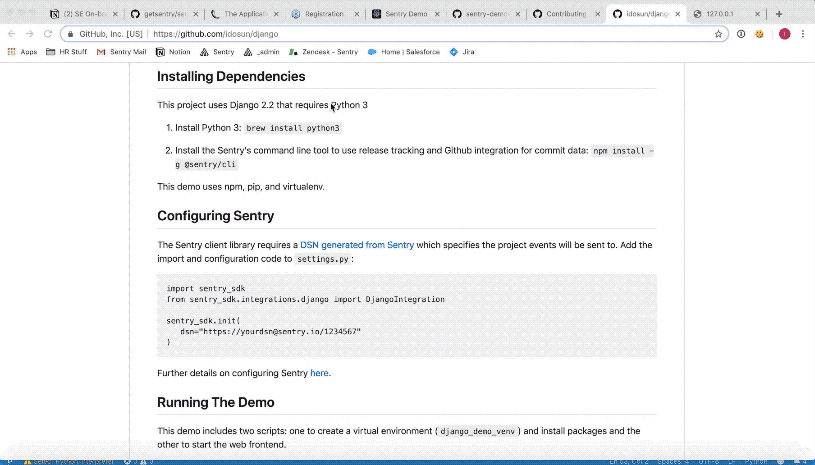Table of Contents
Installing Dependencies
This project uses Django 2.2 that requires Python 3
- Install Python 3:
brew install python3
- Install
virtualenvandvirtualenvwrapper
pip3 install virtualenv virtualenvwrapper
echo "source /usr/local/bin/virtualenvwrapper.sh" >> ~/.bashrc
exec bash
- Install Sentry's command line tool to use release tracking and Github integration for commit data:
npm install -g @sentry/cli
This demo uses npm, pip, and virtualenv.
Configuring Sentry
The Sentry client library requires a DSN generated from Sentry which specifies the project events will be sent to. Add the import and configuration code to settings.py:
import sentry_sdk
from sentry_sdk.integrations.django import DjangoIntegration
sentry_sdk.init(
dsn="https://yourdsn@sentry.io/1234567"
)
Further details on configuring Sentry here.
Running The Demo
Create a python-3 virtualenv (see below) and run deploy target in Makefile.
Virtualenv setup
Setup and activate a Python 3 virtual environment in the project root:
mkvirtualenv --python=python3 sentry-demo-django
To use virtualenv:
workon sentry-demo-django
Runing Django
Running the following command will install relevant python libraries and run django server
make deploy
Demo Specs
This demo uses Django's rest-framework package and offers 3 API endpoints:
- http://localhost:8000/handled - generates a runtime error excplicitly reported to Sentry though the SDk's captureException
- http://localhost:8000/unhandled - generates an unhandled runtime error reported
- http://localhost:8000/checkout - can be used with the Sentry REACT demo store front demo This endpoint can also be used with directly through the Django REST Framework web UI. To generate an error paste the following JSON payload in the POST payload text area:
{
"cart": [
{"id": "wrench", "name": "Wrench", "price": 500},
{"id": "wrench", "name": "Wrench", "price": 500}
],
"email": "user@email.com"
}
Cleaning Up
Pressing Ctrl-C once in each terminal window should stop Django's development server.
To deactivate the virtualenv sentry-demo-django:
deactivate
To remove the virtualenv:
rmvirtualenv sentry-demo-django
